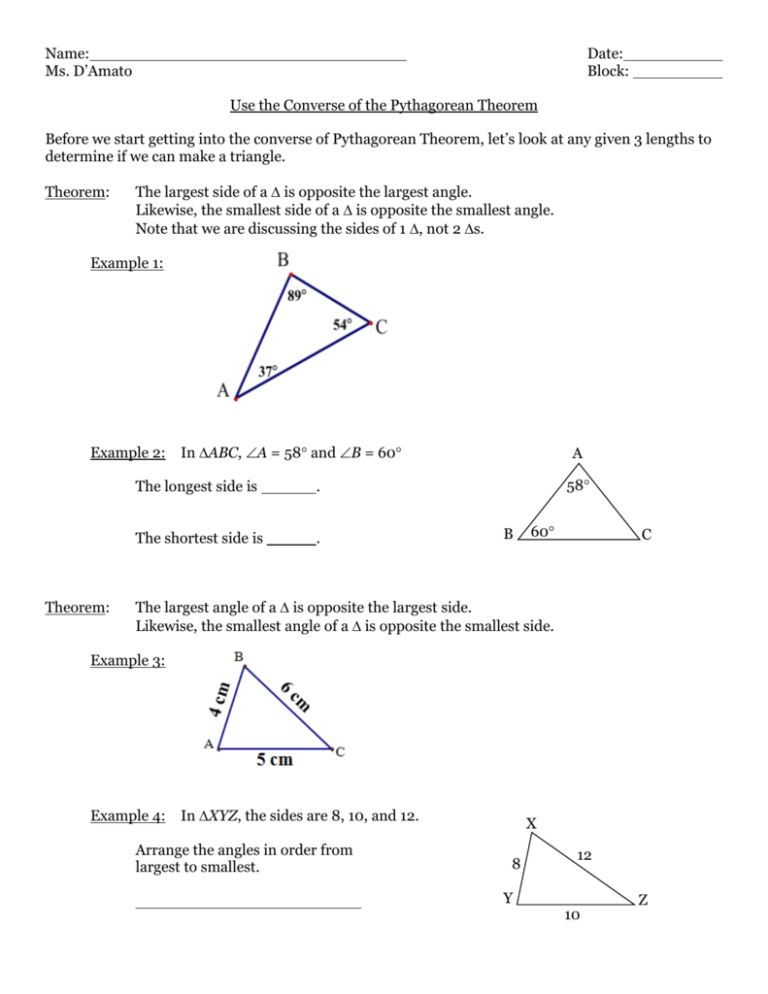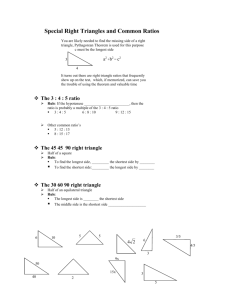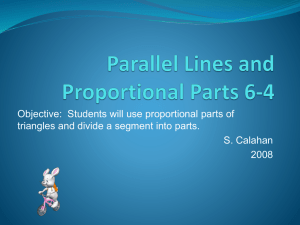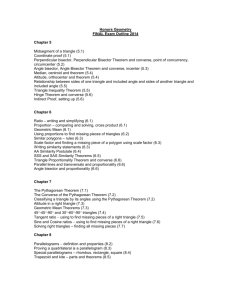54 ° 37 ° 89
advertisement

Name: Ms. D’Amato Date: Block: Use the Converse of the Pythagorean Theorem Before we start getting into the converse of Pythagorean Theorem, let’s look at any given 3 lengths to determine if we can make a triangle. Theorem: The largest side of a is opposite the largest angle. Likewise, the smallest side of a is opposite the smallest angle. Note that we are discussing the sides of 1 , not 2 s. Example 1: Example 2: Theorem: In ABC, A = 58 and B = 60 The longest side is . The shortest side is . A 58 B 60 C The largest angle of a is opposite the largest side. Likewise, the smallest angle of a is opposite the smallest side. Example 3: Example 4: In XYZ, the sides are 8, 10, and 12. Arrange the angles in order from largest to smallest. X 8 Y 12 10 Z Example 5: Order the sides from the shortest to longest: S 75 40 80 R 70 P Q Step 1: Find mP = , mSQR = Step 2: Order the sides of PQS: ______<______<______ Step 3: Order the sides of QRS: ______<______<______ Step 4: Order all 5 sides by combining steps 2 and 3: _______<_______<_______<_______<______ The Triangle Inequality Theorem: the sum of 2 sides of a is greater than the 3rd side. Example 6: Can the lengths below be sides of a ? 3, 4, 7? 12, 2, 9? 5, 12, 10? All you have to do is add the 2 smallest numbers and check to see if their sum is greater than the biggest number! Finding the Range of the Third Side: Since the third side cannot be larger than the other two added together, we find the maximum value by adding the two sides. Since the third side and the smallest side cannot be larger than the other side, we find the minimum value by subtracting the two sides. Example 7: Given a triangle with sides of length 3 and 8, find the range of possible values for the third side. <x< Example 8: Given a triangle with sides of length 15 and 20, find the range of possible values for the third side. <x< Converse of the Pythagorean Theorem: If the square of the length of the longest side of a triangle is equal to the sum of the squares of the lengths of the other two sides, then the triangle is a right triangle. If (longest side)2 = (leg 1)2 + (leg 2)2, then the Δ is a right triangle. Example 9: Is ΔXYZ a right Δ if XY = 8, YZ = 11 and XZ = 10√2 ? Example 10: Is ΔABC a right Δ if AB = 3, BC = 3√3 and AC = 6? Theorem: If (longest side)2 > (2nd side)2 + (3rd side)2, then the Δ is an obtuse triangle. Theorem: If (longest side)2 < (2nd side)2 + (3rd side)2, then the Δ is an acute triangle. Example 11: Is ΔABC with AB = 5, BC = 4, and AC = 4 a right, obtuse, or acute Δ? Example 12: A Δ has sides 4√3, 5√2, and 10. Is it right, obtuse, or acute? Example 13: A Δ has sides 6, 8, and 14. Is it right, obtuse or acute?







